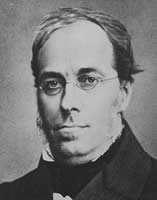- Jules Dupuit
Infobox Scientist
name = Jules Dupuit
box_width =
image_width =
caption = Jules Dupuit
birth_date =18 May 1804
birth_place =Fossano ,Italy
death_date =5 September 1866
death_place =Paris
residence =
citizenship =
nationality = French
ethnicity =
field =economy
work_institutions =
alma_mater = Ecole_polytechnique
doctoral_advisor =
doctoral_students =
known_for =
author_abbrev_bot =
author_abbrev_zoo =
influences =
influenced =
prizes =
religion =
footnotes =
Jules Dupuit (18 May 1804 –5 September 1866 ) was a Frenchcivil engineer andeconomist .He was born in
Fossano ,Italy then under the rule ofNapoleon Bonaparte . At the age of ten he emigrated to France with his family where he studied inVersailles — winning a Physics prize at graduation. He then studied in the Ecole_polytechnique as a civil engineer. He gradually took on more responsibility in various regional posts. He received aLégion d'honneur in 1843 for his work on the French road system, and shortly after moved to Paris. He also studiedflood management in 1848 and supervised the construction of the Parissewer system . He died inParis .Engineering questions led to his interest in economics, a subject in which he was self-taught. His 1844 article was concerned with deciding the optimum toll for a bridge. It was here that he introduced his curve of
diminishing marginal utility . As the quantity of a good consumed rises, the marginal utility of the good declines for the user. So the lower the toll (lower marginal utility), the more people who would use the bridge (higher consumption). Conversely as the quantity rises (people allowed on the bridge), the willingness of a person to pay for that good (the price) declines.Thus, the concept of diminishing marginal utility should translate itself into a downward-sloping
demand function . In this way he identified the demand curve as the marginal utility curve. This was the first time an economist had put forward a theory of demand derived from marginal utility. Although not the first time that the demand curve had been drawn, it was the first time that it had been proved rather than asserted.Dupuit's logic was suspect in that it skipped over the fact that marginal utility is particular to an individual, while market demand is an aggregate. Nothing was said on the interpersonal comparability of utility in order to connect personal marginal utility to aggregate demand. Dupuit, however, did not draw a supply curve and thus did not get price-determination into his story.
Dupuit went on to define "
relative utility " as the area under the demand/marginal utility curve above the price and used it as a measure of the welfare effects of different prices -- concluding that public welfare is maximized when the price (or bridge toll) is zero. This was later known as Marshall's "consumer surplus ".Dupuit's reputation as an economist does not rest on his advocacy of
laissez-faire economics (he wrote "Commercial Freedom" in 1861) but on frequent contributions to periodicals. Wanting to evaluate the net economic benefit of public services, Dupuit analysed capacities for economic development, and attempted to construct a framework for utility theory and measuring the prosperity derived with public works. He also wrote onmonopoly andprice discrimination .Dupuit also considered the
groundwater flow equation , which governs the flow ofgroundwater . He assumed that the equation could be simplified foranalytical solution s by assuming that groundwater ishydrostatic and flows horizontally. This assumption is regularly used today, and is known byhydrogeologist s as theDupuit assumption .References
*Hager, W.H. (2004): "Jules Dupuit—Eminent Hydraulic Engineer". Journal of Hydraulic Engineering, Volume 130, Issue 9, pp. 843–848. doi|10.1061/(ASCE)0733-9429(2004)130:9(843)
*Dupuit, Arsène Jules Étienne Juvénal (1844): "De la mesure de l’utilité des travaux publics", Annales des ponts et chaussées, Second series, 8.
**Translated by R.H. Barback as "On the measurement of the utility of public works", International Economic Papers, 1952, 2, 83-110
**reprinted in: Kenneth J. Arrow and Tibor Scitovsky, eds., Readings in welfare economics (Richard D. Irwin, Homewood, IL, 1969), 255-283.
*Robert Ekelund and Robert F. Hébert: "Secret Origins of Modern Microeconomics: Dupuit and the Engineers" University of Chicago Press, 1999.External links
* [http://cepa.newschool.edu/het/profiles/dupuit.htm Biography of Jules Dupuit]
ee also
*
Robert Ekelund
Wikimedia Foundation. 2010.
